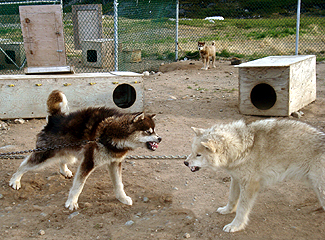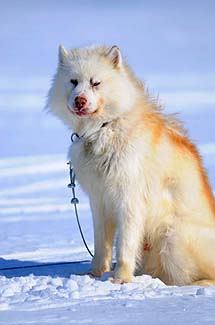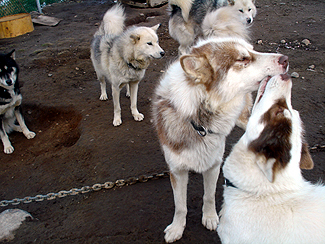In This Issue....
From the EditorIn the News
Ladies' Ellesmere Vacation
Sled Dog Physiology: Non-Invasive Techniques
BAS Vignette: How Do You Say Good-bye?
Sledge Dog Memorial Fund Update
Report: The Chinook Project in Kimmirut
Bannock revisited
Book Review: Land of the Long Day
Behavior Notebook: On Being a Social Facilitator
Tip: Dealing with Those "Dirty" Boots
Index: Volume 10, The Fan Hitch
Navigating This
Site
Index of articles by subject
Index
of back issues by volume number
Search The
Fan Hitch
Articles
to download and print
Ordering
Ken MacRury's Thesis
Our
comprehensive list of resources
Talk
to The
Fan Hitch
The Fan
Hitch home page
ISDI
home page
Editor's/Publisher's Statement
Editor: Sue Hamilton
Webmaster: Mark Hamilton
The
Fan Hitch, Journal of the Inuit Sled
Dog, is published four times a year. It is
available at no cost online at:
https://thefanhitch.org.
The Fan Hitch welcomes your letters, stories, comments and suggestions. The editorial staff reserves the right to edit submissions used for publication.
Contents of The Fan Hitch are protected by international copyright laws. No photo, drawing or text may be reproduced in any form without written consent. Webmasters please note: written consent is necessary before linking this site to yours! Please forward requests to Sue Hamilton, 55 Town Line Rd., Harwinton, Connecticut 06791, USA or mail@thefanhitch.org.
This site is dedicated to the Inuit Dog as well as related Inuit culture and traditions. It is also home to The Fan Hitch, Journal of the Inuit Sled Dog.
The Fan Hitch welcomes your letters, stories, comments and suggestions. The editorial staff reserves the right to edit submissions used for publication.
Contents of The Fan Hitch are protected by international copyright laws. No photo, drawing or text may be reproduced in any form without written consent. Webmasters please note: written consent is necessary before linking this site to yours! Please forward requests to Sue Hamilton, 55 Town Line Rd., Harwinton, Connecticut 06791, USA or mail@thefanhitch.org.
This site is dedicated to the Inuit Dog as well as related Inuit culture and traditions. It is also home to The Fan Hitch, Journal of the Inuit Sled Dog.

Two subordinate males gaining a sense of superiority while on
the chain. Aggression such as this rarely occurs when the dogs
are roaming freely under the watchful eye of the boss dog.
photo: Heather Rose Etok
On Being a Social Facilitator
by Mark Brazeau
Sometimes people try to point out to me that raising a team of Inuit Sled Dogs is too much work and takes too much time. For them, a six-month mushing season, no matter how enjoyable it may be, does not justify the year-round dedication that is required. The first thing which enters my mind is, "They just don’t get it." For me, and for other mushers, the off-season is as enjoyable as the winter season, but for different reasons. When you do "get it", everything related to raising a team of sled dogs is rewarding and enjoyable. Building sleds, attending to the harnesses and ropes, vaccinating, breeding and feeding are just some of the many activities that add to the whole experience of being a musher. For me, personally, the one aspect of raising Inuit Sled Dogs that trumps all others, besides mushing of course, is the socialization of the dogs. When I use the phrase, "socialization of the dogs", I use it very loosely. I believe that socializing dogs is not something the musher actively does. The hierarchy within the team is decided by the dogs – the musher only acts as a social facilitator.
Failing to facilitate the social structure in a team will lead to vicious battles within the hierarchy and detrimental consequences. The first, and most unfavourable result of failing to facilitate the social structure is fighting that may cause injury and possibly death. It is a fact that Inuit Dogs will fight, no matter how much attention is paid to the social dynamics. But if a musher is attentive to the social intricacies of the team, the amount of fighting can be significantly reduced. The second repercussion of failing to facilitate the social structure is lack of performance. Dogs that are anxious about their place within the social hierarchy will not pull with the same vigor as dogs that are content and confident.

Mirqulak is the "aggressive subordinate"
that cannot seem to find his place in the
hierarchy. Notice the scars on his face.
photo: Pascal Poulin
As confirmed by Kangiqsualujjuaq Elder, Tivi Etok, in the past the Inuit never tied their dogs. When the dogs were not pulling, they were allowed to roam freely and interact with each other constantly. And as expected, a hierarchy would develop among them, with the boss dog being at the top. If a musher had a good boss dog, there was very little social unrest and the dogs pulled hard when it was time to get to work. Sometimes, however, even though a musher had a good boss dog, aggressive dogs in the team would cause fights and challenge the boss dog. According to Tivi, these types of dogs were born with an aggressive disposition. And, before an aggressive subordinate such as this had a chance to destroy the entire social network of the team, it was advantageous for the musher to assist the boss dog in putting the "trouble-maker" in his place. Sometimes the musher would muzzle the subordinate dog or secure its front leg to the side of its head with a rope. Restraining the subordinate aggressor in this way ensured that the boss dog won the fights with the aggressor and retained his position at the top of the hierarchy. Tivi explained that on some occasions, he even physically held down a subordinate aggressor so the boss dog could put a licking on him. It may seem that these methods were extreme but, as Tivi explained, the Inuit needed their sled dogs to pull all day, everyday. A sound social hierarchy allowed the dogs to function with the highest level of efficiency - the Inuit could not tolerate the dogs fighting over social position while on the trail.
As a rookie in the world of Inuit Sled Dogs, I have made several rookie mistakes – and continue to do so for that matter. Most mistakes were not too serious and could be corrected. However, as I have now learned, mistakes in the realm of social facilitation are very costly and I am still paying today. My two most critical mistakes were (1) not allowing the pups to thoroughly fight for their social status and (2) staking the dogs out on chains.
When Inuit Sled Dog pups get into a fight, it is a ferocious scene. When two cute little balls of fur instantly transform into savage beasts - it seems as though one or both will not come out alive. The savagery is magnified when a group of sibling pups "gang up" on a lone non-sibling. Three years ago, in my novice ignorance, I separated and protected a lone pup from being "bullied" by a group of siblings. Little did I know that I was causing far more harm than good. Now fully grown, the little puppy I once protected is a massive beast of a dog that is constantly fighting and threatening to destroy the social structure within my team.
To make matters worse, a local bylaw obligates all owners to chain their dogs – a logical and necessary regulation in a modern Inuit community. But, by not allowing the dogs to interact and develop their hierarchy, social chaos will invariably ensue. The chain gives subordinate dogs a false sense of superiority. When the dogs are roaming freely, the boss dog gives dozens (or perhaps hundreds) of cues per day to the subordinates. A growl here, a nip there, a lot of urine everywhere, and the subordinates are kept in check. But as dogs pass time on their chains, they start to forget who the boss is because they are not constantly reminded. As a result, their courage grows until they begin believing they are prepared to take on the boss dog. As soon as the dogs are off the chains and in a fan hitch formation, all hell breaks loose.

Dogs that are lower on the hierarchy display submissive
behaviour to the boss dog photo: Brazeau
In an attempt to right past wrongs, I have constructed a very large pen where the dogs can run freely and interact. Of course, I could not just unleash all the dogs simultaneously into the pen. The integration of each dog into the pen was gradual and calculated. But because of mistakes I had made while the dogs were pups, two dogs still need to be chained within the pen, and my very "aggressive subordinate" needs to be separated from the group entirely. Needless to say, since freeing the dogs from their chains, things have greatly improved. The boss dog does a great job of keep all the subordinate dogs in order and fighting is almost non-existent. Yet, even though things have improved, I feel as though I cannot become too complacent. I must always be very attentive to the many social cues the dogs are sending one another. I cannot assume that there will be no shifts or challenges to the hierarchy. Luckily for me, I find the group dynamics of the team truly fascinating. I could stand outside the pen for hours observing the social behaviour of the dogs.
It goes without saying that as I continue to develop as a musher, I will continue to make mistakes. Learning from and correcting those mistakes will assure me some level of success as opposed to total frustration. Mushing dogs is very challenging. A team of dogs does not come equipped with a throttle and steering wheel. A musher must deal with a group of several animals that are unique, each with its own disposition. In order to function effectively, the dogs must work together as a cohesive unit. Ensuring that the social structure within the team remains in good condition is the responsibility of the social facilitator.
A very sincere thank-you to Tivi Etok for sharing the knowledge that contributed to this article. His insight and enthusiasm are always a pleasure to receive.
Tivi Etok sharing his traditional knowledge with translator
Nancy Brazeau photo: Brazeau